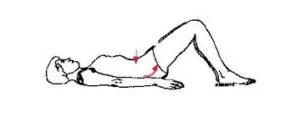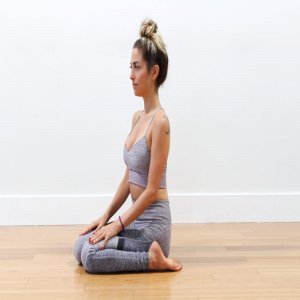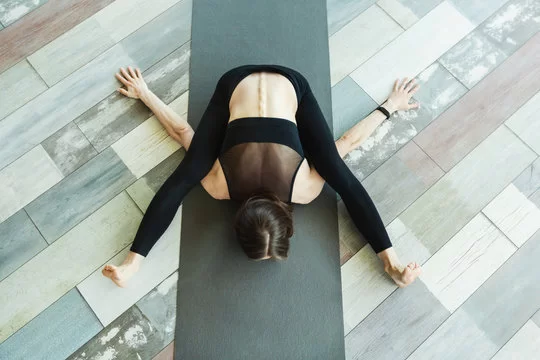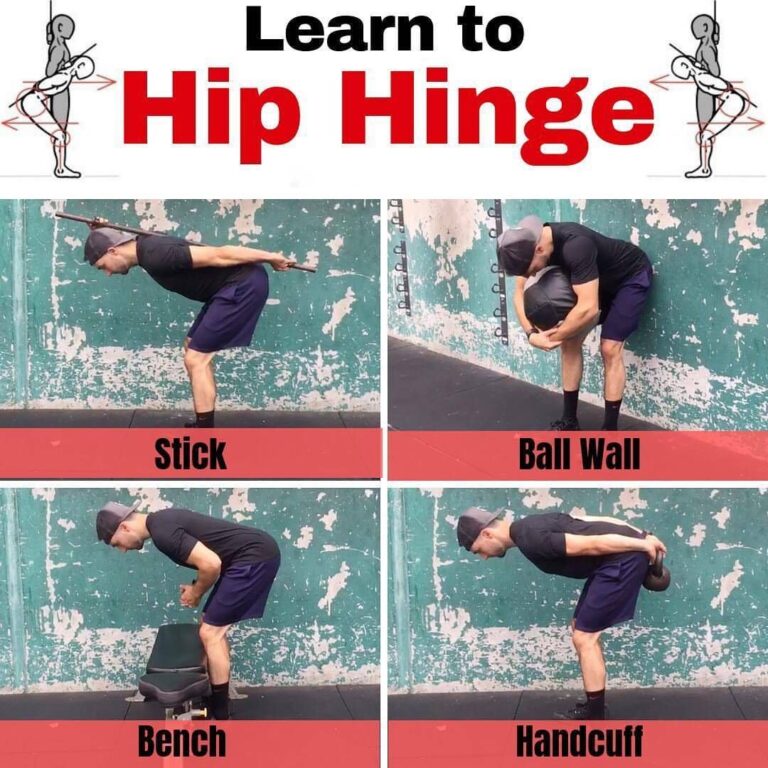Latissimus Dorsi Stretch: Health benefits, How to do?
Latissimus dorsi stretch is an important exercise to improve the flexibility of your upper body, If you are performing this exercise helps to reduce the risk of injury and also improves your fitness level.
What is latissimus dorsi stretch?
The latissimus dorsi is one of the biggest muscles in the back. It’s sometimes known as your lats and it has a large, flat “V” shape. It reaches the width of your back and helps control the motion of your shoulders.
When your latissimus dorsi muscle is injured, you might feel the ache in your lower back, mid-to-upper back, along the bottom of your scapula, or in the back of your shoulder. You may even feel pain on the inside of the arm, all the way up to your fingers.
Stretching of lats is very important for your back because it gives strength to your back. This is important for your posture also.
What are the advantages of doing latissimus dorsi stretch?
There are some benefits you can achieve by stretching, these are :
- It helps stabilize your spine.
- This also helps for shoulder and arm motion.
- It supports good posture.
- It is essential for building upper-body strength.
- Improve range of motion that also slow the degeneration of the joints.
- It prevents injury.
- Decreases muscle tightness and stiffness.
- It reduces the risk of injury.
- This helps to relieve post-exercise aches and pains.
- Stretching can also reduce muscular tension and increase muscular relaxation.
- Increase mechanical efficiency and overall functional performance.
- Stretching before an exercise allows your muscles to loosen up and able to give the impact of the activity you choose to perform.
- Stretching promotes circulation at the sides of your body.
What are the types of latissimus dorsi stretching?
There are so many techniques for doing latissimus dorsi stretching:
- Latissimus dorsi stretch
- Elbow Pull
- Side Lie On Exercise Ball
- Latissimus Stretch Whilst Sitting
- Door Frame Lean
- Side Bend With Resistance Band
- Side Lie Stretch
- Hanging Latissimus Stretches
- Eccentric Loading Of The Latissimus Dorsi
- Performing a Pelvic tilt
- Active floor stretch
- Foam rolling
- Exercise ball stretch
- Wall press
- Upward Salute
- Cat-Cow pose
- Downward-Facing Dog
- Child’s Pose
Latissimus Dorsi Stretch
How to: Stand straight. your back is straight and your hands are straight above your head.
Slowly lean towards either of your sides.
You feel a stretch on your opposite side.
Hold for 8-10 seconds and repeat 6-8 times.
Latissimus Dorsi Stretch Video
Elbow Pull
How to: Move your right hand down towards the middle back part.
Place your left hand onto the right elbow that is moving down the back.
Pull the right elbow towards the midline.
Tilt your upper body towards the side.
When you feel stretched, hold there for 20 seconds.
Side Lie On Exercise Ball
How to: Lie on your left side on an exercise ball.
Maintain your feet’ position near the ball to maintain balance.
Reach over with the right arm.
You feel a stretch on your right side.
Hold it for 30 seconds and repeat on the left side.
Latissimus dorsi Stretch Whilst Sitting
How to: Take a sitting position on a chair with a table in front of you.
Pot your both elbows aiming forwards onto the border of the table.
Draw your hips backward from the table.
Allow your chest to let fall.
You feel a stretch on both sides, hold for 25-30 seconds.
Door Frame Lean

How to: Stand the side of a door frame, so your body parallels to the door.
Now hold a door frame with your opposite side of a hand from a door.
Now bend towards the side of a door frame at your waist level.
Use your weight to sink into a stretch.
Twist your pelvis opposite side.
You feel a stretch on the side of your upper body.
Hold it for 20-30 seconds and repeat it 2-3 times.
Side Bend With Resistance Band

How to: Stand tall sideways of a static object where you have to tie up a resistance band above your head level.
Hold a band with the opposite side of a hand.
Step away from an object until you create tension in a band.
Relax your arm so your body weight sinks onto the resistance band.
Your mostly body weight onto a leg that is far away from a band.
Twist the pelvis away.
You bend at a waist level as you feel a stretch.
Hold it for 30 seconds and release.
Side Lie Stretch
How to: Take a side-lying position on either side.
Put your lower elbow on a couch.
Move your body to sink towards the ground.
Stretch the lower leg away from your body.
Hold there for 30 seconds and release.
Hanging Latissimus Stretches
How to: Stand tall under a bar that is above your head level.
Grasp the band with both hands and hang on.
Relax your body to feel a stretch.
Maintain your feet to lightly rest on the ground.
Hold it for 25-30 seconds.
To feel a deep stretch you can apply weight onto your ankle.
Eccentric Loading Of The Latissimus Dorsi
This includes creating a muscular contraction whilst the muscle is lengthening. This will stretch the Latissimus Dorsi.
How to: Take a lying position on a floor with your knees are bent.
Maintain your lower back fully flat on the ground throughout the exercise.
Hold a weight with your both hands.
Gently lower the weight downward above your head level without moving your lower back to the arch.
You can feel a stretch at the end of a motion.
Hold for 15 seconds and repeat 7-8 times.
Performing a Pelvic tilt

How to: Lie down on the ground.
Gently bend both knees and slide them towards your body.
Your feet should be touching the ground.
Your hands at your either side.
Now lift your waist/pelvic or midsection of your body upwards towards the ceiling.
Keep your feet touching the ground.
When you feel a stretch at the sides of a body stop there.
keep that position and hold it for 5-10 seconds.
Then lower down your waist and do it again.
You can increase a hold time after some time when you feel comfortable in 5-10 seconds holding time.
Active floor stretch
How to: Take a kneeling position.
Put your left forearm along the ground.
Lean your weight onto your left arm and stretch out your right arm.
You feel a stretch on your right side.
Hold it for 20 seconds and repeat.
Foam rolling

How to: You need a foam roller for this stretching.
Lie on your left side with the foam roller under your latissimus, keeping a neutral spine.
Keep your left leg straight and bend your right knee however is comfortable.
Roll forward with your right arm straight forward above your head.
You feel stretched on your right side.
Holding time is 20-30 seconds.
Do it on another side.
Exercise ball stretch

How to: Start on all fours in a tabletop position. put an exercise ball in front of you.
Place your left hand on the ball with your thumb facing the roof.
Press into your right arm which is touching the floor for stability and support.
Engage your core muscles as you extend your left arm straight out, rolling the ball forward.
To feel a stretch, you have to hold for 20-30 seconds in this position.
Repeat on the right side.
Perform each side 2–3 times.
You can perform it on a chair also by replacing it in a ball position.
Wall press
How to: You can stand in front of a wall 2 feet away, facing towards a wall.
Place your palms flat, touching on a wall.
Bent forward at a waist and forward your wait onto your palms
You feel stretch on your sides, hold for around 1 minute.
Release and repeat 2 times.
Upward Salute
How to: Stand tall with your arms on either side.
Your feet are slightly apart from each other and your body weight is evenly distributed on both feet.
Raise your both arms upwards towards the ceiling.
Engage your core muscles and keep your spine straight.
Slightly bend backward to feel more stretched.
Hold for 20 seconds and release.
Downward-Facing Dog
How to: Start on all fours with your wrists and your shoulders in the same line and your knees below your hips.
Tuck the toes under and raise your hips off the ground.
Straighten the legs and draw your heels toward the ground (they do not have to be on the ground). If your hamstrings are tight, then slightly bend your knees.
Push firmly through your palms and focus on widening across your clavicles and shoulders. Move your chin to tuck into your chest.
You feel stretched at the sides of your body. Hold there for 20 seconds.
Child’s Pose
How to: Take a kneeling position on a floor.
Now bend at your waist and straighten your arms forward to touch the floor.
Reach your hands forward as far as possible to feel stretch on your sides of the body.
Keep your knees and heels in a position during the stretch.
Breath normally. when you feel stretched, take a 20-30 seconds hold.
Repeat 2-3 times.
What are the safety and precautions of latissimus dorsi stretching?
There are some precautions you need to take care of during stretching:
- Don’t bounce. Stretch in a smooth motion, without bouncing. Bouncing during a stretch can injure your muscles and cause muscle tightness.
- Hold your stretch. Breathe normally and hold every stretch for around 20- 30 seconds.
- Never aim for pain. Expect to feel tension while you are stretching, not pain. If you feel pain, stop right there and don’t push hard.
- Keep up with your stretching. this can be time-consuming. But you can reach the most advantages by stretching daily, at least 2-3 times a week.
- If you have a prior condition or an injury, you need to adjust your stretching techniques. Consult your physical therapist if you have a problem.
- Remember that stretching also makes you injured. Stretching won’t prevent an overuse injury.








One Comment